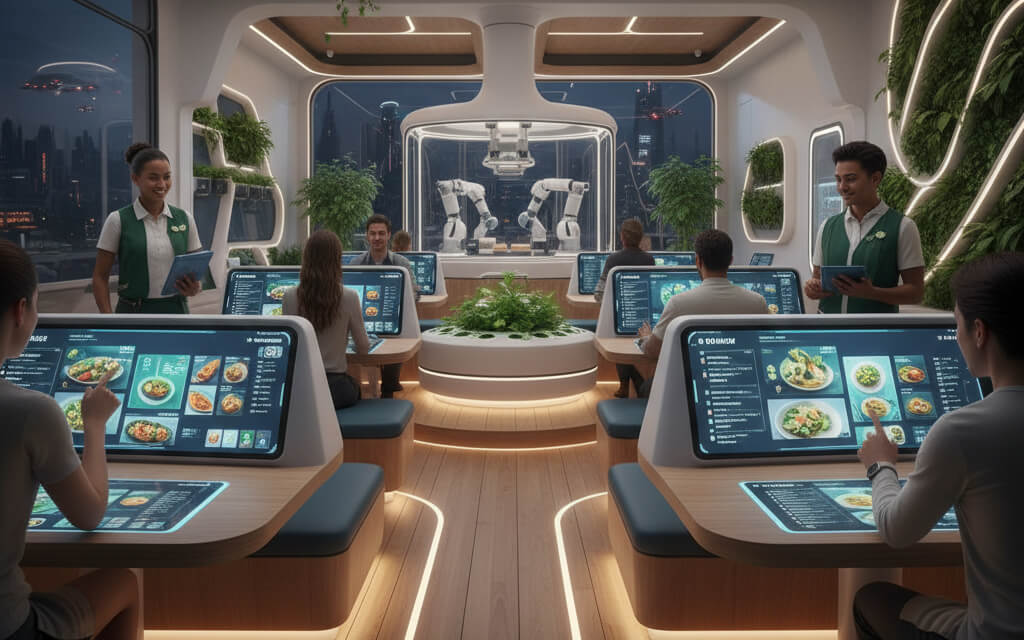October 14, 2025

As we navigate 2025, the restaurant industry stands at the crossroads of tradition and transformation. The old rules of hospitality — built on linen napkins, hushed dining rooms, and exclusive tasting menus — are giving way to a new reality shaped by digital fluency, ethical consciousness, and experiential depth.
Restaurants are no longer just spaces for eating; they are brands, theaters, community hubs, and cultural storytellers. Diners expect more than just great food — they want emotional engagement, ethical transparency, and seamless digital touchpoints at every stage.
From AI-powered kitchens to hyper-personalized service, the dining landscape is shifting rapidly. Whether you operate a high-end establishment or a fast-casual concept, understanding these trends isn’t optional — it’s survival.
Let’s dive into the defining elements of restaurant success in 2025.
In 2025, your staff are no longer just workers — they are live representatives of your brand identity. Hostesses, servers, and bartenders serve not just meals but stories. A modern server must be part sommelier, part influencer, part customer success agent.
As outlined in RocketPages’ guide on staff-driven web engagement, a trained team can directly influence online visibility, customer retention, and even local SEO rankings.
“A host who can articulate your mission is more valuable than one who just smiles. Today’s front-of-house is your front-facing brand.”
— Maya Laurent, Hospitality Consultant
In the digital-first era, a restaurant’s online presence is its new front door. Guests often form their entire perception of a restaurant before ever stepping inside — based purely on your website, Google profile, social media, and online reviews.
This guide on website mistakes outlines common digital pitfalls that quietly drive customers away — including outdated menus, broken links, and confusing layouts.
Tools to streamline digital presence:
Artificial Intelligence is transforming kitchen operations from reactive to proactive, predictive, and precise. In 2025, top-tier kitchens use AI not only for automation but for culinary enhancement.
These systems reduce human error, improve consistency, and allow chefs to focus on creativity rather than repetition.
“AI doesn't replace the chef — it removes the drudgery so the chef can shine where it matters most.”
— Dario Freeman, Executive Chef & Consultant
Diners today want to feel good about what they eat and who they support. Trust is built through openness — not just in flavor, but in values.
This reputation management playbook shows how consistent storytelling, honest responses, and visible social proof can drive long-term loyalty.
Pro tip: Turn your values into marketing by posting sourcing stories, team spotlights, and behind-the-scenes prep footage.
In 2025, restaurant marketing is no longer reactive — it’s strategic, personalized, and predictive. Tools like Google Analytics 4 and Meta Ads Manager allow for pinpointed messaging that turns browsers into loyal guests.
This Google Ads guide shows how even small restaurants can outperform larger chains with smart, local campaigns.
Marketing is no longer about “blasting promotions” — it’s about building relationships at scale.
Sustainability in 2025 is not just about green packaging — it’s about designing experiences that respect the planet and inspire the senses.
Modern diners don’t just care about eco-friendly — they want eco-beautiful.
Authenticity in 2025 is rooted in local relationships and cultural respect. Restaurants are going beyond farm-to-table and leaning into neighborhood-to-table experiences.
These practices elevate not only flavor but community connection — a form of luxury built on roots, not rarity.
In an era of content overload, experience is the last frontier. The best restaurants aren’t just feeding guests — they’re **delighting, surprising, and moving them**.
“People remember how a meal made them feel, not just how it tasted.”
— Kevin Long, Experiential Design Consultant
As 2025 continues to unfold, restaurants that merge innovation with intention will lead the way. From AI in the kitchen to sustainability on the plate, and from digital marketing to emotional storytelling, success depends on integration, not isolation.
This is no longer just the food business — it’s the experience economy. Guests are seeking brands that understand their values, respond to their needs, and provide moments they’ll never forget.
So ask yourself:
Because the future doesn’t wait — and neither do your guests.
Stay up to date with the latest tips, expert insights, product reviews, and step-by-step guides to help you grow, create, and succeed—no matter your industry or passion.